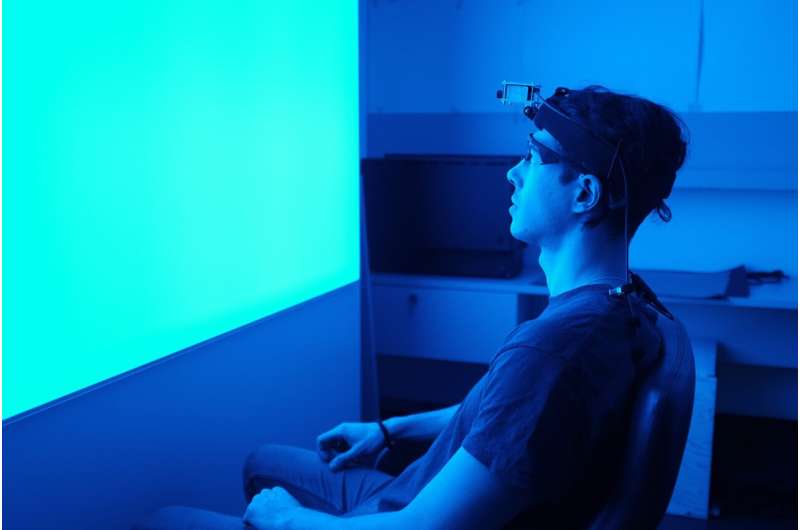This article has been reviewed according to Science X's editorial process and policies. Editors have highlighted the following attributes while ensuring the content's credibility:
fact-checked
peer-reviewed publication
trusted source
proofread
Pupil dilation decreases with age: Poor lighting conditions can reduce quality of life, finds study

Our eyesight declines with age and poor lighting or strong contrasts between light and dark can limit the ability of older people to react in everyday life, resulting in a negative impact on the sleep-wake-rhythm.
As neuroscientists at the Max Planck Institute for Biological Cybernetics in Tübingen and the University of Basel confirm, this is also due to the diminishing ability of the eye´s pupil to dilate sufficiently. Their results have been published in the journal Royal Society Open Science.
When driving in the evening, oncoming vehicles can dazzle you and impair your vision. Sometimes so badly that you can only make out the edges of the road, the road median or people. Although situations like this do not exclusively affect older people, their pupils seem to react less agilely to dynamically changing light stimuli compared to younger people.
To test their assumption, the scientists equipped women and men aged between 18 and 87 with a compact and mobile measuring device in a field experiment under natural lighting situations—and also examined them in a laboratory experiment under controllable lighting conditions.
"Many findings about the pupil come from pure laboratory tests. It is important to us that the results are comparable and directly transferable to everyday life. That's why we designed the study to be as close to everyday life as possible," explains Rafael Lazar, Ph.D. student at the Center for Chronobiology at the University of Basel, Switzerland.
Incidentally, this study is unique in its form because it has not yet been technically feasible to carry out measurements under real-life conditions with a very compact and mobile solution.
The participants were exposed to various everyday situations under typical lighting conditions during the day: indoors with artificial and natural light, at work on a computer with an LED screen and outdoors on a walk under natural light.
In the laboratory, all test subjects were then also exposed to artificial light of different wavelengths (red, green, blue and white) and their pupil dilation was measured for comparability and controllability with other studies.
Pupil width declines by around 0.4 millimeters per decade
"Our results confirm the hypothesis that the pupil's ability to adjust to varying light situations decreases as we get older. Based on our broad sample, we can determine that the pupil width declines by around 0.4 millimeters per decade. Young people see dimly lit night environments better than older people due to the greater agility of their pupils," explains project leader Manuel Spitschan, who is a research group leader at the Max Planck Institute for Biological Cybernetics and a professor at the Technical University of Munich, School of Medicine and Health.
When light enters the eye, the pupil functions like the aperture of a camera and the retina like a light-sensitive sensor: in bright light, the pupil closes to a diameter of up to two millimeters, allowing less light to reach the stimulus-sensitive light receptors of the retina inside the eye. In dim light, it opens up to eight millimeters so that more light can reach the brightness- and color-sensitive cells of the retina.
If the incidence of light becomes too high, the visual perception would correspond to overexposure; if there is not enough light, it would result in underexposure.
"In the home or at work, decreasing visual acuity can play a role to the disadvantage of the general quality of life and work due to reduced pupil dilation. If the eye has to adjust quickly to changing brightness levels, too much contrasting lighting in the outdoor area of a house at night or on a staircase can lead to a tripping hazard. In the workplace, a well-lit environment without glare can help if people need to react quickly or require a high level of concentration. This is crucial in working environments with a higher risk of injury," recommends Manuel Spitschan.
Impact on sleep-wake-rhythm of elder people
The illumination of the retina is also important for our internal clock, as it is constantly synchronized with the surrounding environment through the alternation of light and dark. The current study showed that older people have much less light available for their circadian clock.
This has an impact on physical well-being, especially on healthy sleep. "We know that older people have a higher vulnerability to disruption of their sleep-wake cycle. Our study shows that the dose of light that we need to support our health and well-being may need to be adjusted as we age, though there is also evidence that our brain also adapts. Future research will tease apart how to turn this into actionable recommendations for everyone—young and old."
It is also interesting to note that eye color, gender or caffeine consumption have no influence on visual acuity in connection with pupil dilation as people age.
More information: Rafael Lazar et al, Regulation of pupil size in natural vision across the human lifespan, Royal Society Open Science (2024). DOI: 10.1098/rsos.191613



















